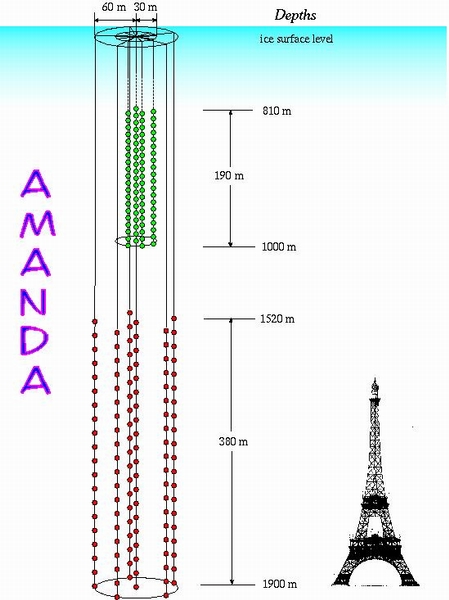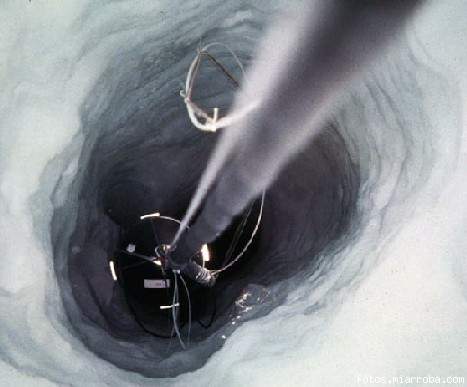|
|
|||
|
The Antarctic Muon and Neutrino Detector Array ..
|
|||
|
AMANDA, when completed, will reach a depth equal to
more than two and one-half times the height of the Eiffel Tower. Into each
of the eight holes melted into the glacial ice are lowered strings, each
studded with 20 modules that can detect and record neutrinos as they pass
through the ice.
Whenever scientists have looked at nature through "new eyes," using probes previously unavailable, unanticipated discoveries have resulted. Examples include Galileo's use of the telescope to discover Jupiter's moons and Saturn's rings; the use of x-rays to see inside of living tissue; and the different universe that is seen in the infrared, x-ray and gamma-ray portions of the electromagnetic spectrum. In the past decade or two technology has made it feasible to build a "telescope" that can image the sky in high-energy neutrinos. Neutrinos, one of the most common subatomic particles in nature, interact only weakly with ordinary atoms, making detection difficult. Even though an enormous flux of neutrinos continuously bombard Earth, almost all pass completely through without interaction. Because neutrinos are so penetrating, they allow astronomers to see inside such celestial objects as the cores of galaxies, enshrouded with dust and gasses that obstruct observations made with any wavelength of electromagnetic radiation. However, detecting a neutrino takes an enormous detector with a very good filter. The solution to this problem is to use cheap material for the detector, with a large shield to keep out unwanted radiation and particles. So far the only candidates for the detector material are water or ice. The shield is provided by looking for only upward-going neutrinos that must have passed through Earth, something no other known particle can do. The detector also should be buried deeply to limit interference from downward-going muon particles that cosmic rays produce in the atmosphere. Detectors currently under construction are DUMAND in the Pacific, NESTOR in the Mediterranean, BAIKAL in Lake Baikal, Russia, and AMANDA at the South Pole. Ice has advantages and disadvantages compared to water. On the plus side, there is no radioactivity or bioluminescence, and the photodetectors operate at low temperature, which all reduce background. Also, ice forms a solid working surface above the detector, eliminating the need to run signals for tens of kilometers to shore and greatly simplifying the electronics. On the minus side, because the photodetectors are permanently frozen into the ice sheet, bad modules must be replaced rather than fixed. Additionally, because the ice sheet is not as thick at South Pole (2.8 km) as the depth of the ocean in many places, it is not possible to get as much shielding from cosmic-ray-produced muons as at DUMAND. One mixed blessing of working at the South Pole is that the entire northern sky can be watched all the time, but the southern sky is never in the field of view. So far the AMANDA collaboration (University of Wisconsin, Universities of California Berkeley and Irvine, Universities of Stockholm and Upsalla in Sweden, and DESY in Germany) has installed at South Pole eight long strings with 166 optical modules, at depths ranging from 800 to 2,200 meters. The ice is much clearer than anticipated from laboratory measurements; however, at the shallower depths (less than 1,500 meters) air bubbles remain and cause excessive scattering, making that part of the ice sheet less useful. Consequently, future development is expected to be done in deep ice. Although the detector is only about one quarter finished, the AMANDA collaboration has already begun looking for neutrinos. AMANDA also is being used to detect supernova and gamma-ray bursts. Surprisingly, the major results to date concern the optical properties of the bulk ice. Not only is the ice is much clearer than any laboratory measurement of "pure" water ice, but it also appears to be to be clearer than many other "clear" solids such as salt. The AMANDA results have initiated a rethinking of the optical nature of solids and may well produce fundamental contributions to condensed matter science. |
|||
..
..
|
|||
| FAIR USE NOTICE: This page contains copyrighted material the use of which has not been specifically authorized by the copyright owner. Pegasus Research Consortium distributes this material without profit to those who have expressed a prior interest in receiving the included information for research and educational purposes. We believe this constitutes a fair use of any such copyrighted material as provided for in 17 U.S.C § 107. If you wish to use copyrighted material from this site for purposes of your own that go beyond fair use, you must obtain permission from the copyright owner. | |||
|
|




